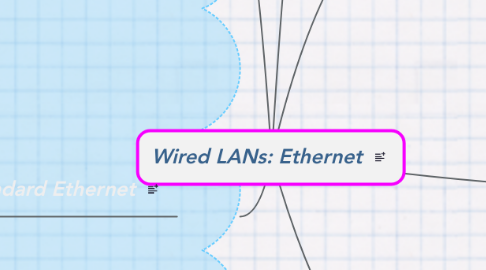
1. IEEE Standards
1.1. Data link layer - divided into logical link control sublayer & (MAC) sublayer
1.2. Physical layer - divided into Pyhsical Layer signaling(PLS) sublayer, Medium Attachment Unit (MAU) and Medium dependent interface (MDI).
2. Standard Ethernet
2.1. Data Link Layer
2.1.1. LLC sublayer is responsible for the data transmission between computers or devices on a network.
2.1.2. MAC is responsible for the transmission of data packets to and from the network-interface card and to/from another remotely shared channel.
2.1.3. MAC Sublayer
2.1.3.1. The protocols used to determine who goes next on a multi-access channel belong to sublayer of data link
2.1.3.1.1. FRAME FORMAT
2.1.3.1.2. FRAME LENGTH
2.1.3.1.3. ADDRESSING
2.2. Pyhsical layer
2.2.1. 10Base5
2.2.1.1. Connections are made using tap to a thick coaxial cable. Therefore, poor connection between the comp and coaxial cable.
2.2.2. 10Base2
2.2.2.1. Cheap and has a good connection between the computer and coaxial cable
2.2.3. 10Base-T
2.2.3.1. Stations are connected to a hub via two pairs of twisted cable.
2.2.4. 10Base-F
2.2.4.1. Good for high speed connections between buildings
3. Local Area Network(LAN)
3.1. A a group of computers and associated devices that share communications line or wireless link to a server.
3.2. Eg: Ethernet, Token Ring
3.2.1. Topic #3
4. Types of Ethernet
4.1. FAST ETHERNET
4.1.1. Can transfer data at a rate 100 Mbps using twisted-pair or fiber-optic cable.
4.1.2. Based on the proven CSMA/CD MAC protocol, and uses existing 10BaseT cabling
4.1.3. Data can move from 10 Mbps to 100 Mbps without any protocol translation or changes to the application.
4.2. GIGABIT ETHERNET
4.2.1. Capable of transferring data at a rate of 1000 Mbps based on twisted-pair/fiber optic cable
4.2.2. Twisted-pair cables that support Gigabit Ethernet is Cat 5e cable that are used to achieve high data transfer rates
5. 10 Gigabit Ethernet
5.1. Transmit data packets over Ethernet at rate of 10 billion bits per second.
5.2. 10 GbE have advantage of full-duplex protocol, in which data is transmitted in both directions by using a networking switch to link devices.
5.3. Advantages of 10 Gigabit Ethernet
5.3.1. Low-cost bandwidth
5.3.2. Faster switching
5.3.3. Straightfoward scalability - upgrading from 1GbE to 10 GbE is simple because their path upgrade paths are similar.
6. Changes in the Standard
6.1. Bridged Ethernet
6.1.1. Divides the network into 2 or more networks, can gain more bandwidth for each segment.
6.2. Switched Ethernet
6.2.1. The bandwidth is shared only between the station and the switch
6.3. Full-Duplex Enthernet
6.3.1. Station can either send or receive data at the same time

